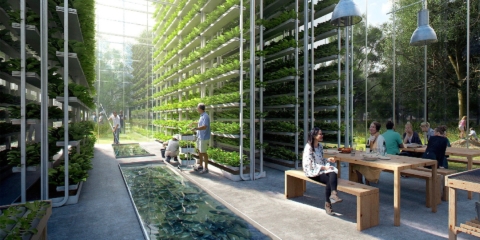Would you like to get notifications from Christian?
We have all seen the movies and read books where a future city is a complete and utter mess. Skyscrapers that are falling apart, streets that are overcrowded and polluted, and a general feeling of chaos. However, this does not have to be our future! With the help of an AI imagery program, we can see what our cities could look like if they were designed with sustainability. In this blog post, we will take a look at the work of Manas Bhatia, an architect who is using AI to create beautiful and sustainable structures for the future.

photo-manas-bhatia
As our population grows, we must start thinking about how to design our cities to be sustainable. With the help of AI, we can create buildings that are not only aesthetically pleasing but also serve a purpose. For example, Manas Bhatia's "air purification towers" would not only look beautiful but would also help to keep the air clean!

photo-manas-bhatia
This is a fascinating time for architecture and sustainability! With the help of AI, we can create radical visions of future cities that are both beautiful and sustainable. As more architects and designers begin to use AI-powered techniques, we will start to see a radical change in the way that future cities are designed. We will move away from traditional designs that are focused on maximum efficiency and towards designs that are focused on aesthetics and sustainability. This is an inspiring time for architecture and sustainability! With the help of AI, we can create radical visions of future cities that are both beautiful and sustainable. We hope that more architects and designers will use this technology to create a bright future.

photo-manas-bhatia
Do you think it is a step in the right direction? Or do you think it is unnecessary? Let us know in the comments below!
Author: Christian Kromme
First Appeared On: Disruptive Inspiration Daily
Christian is a futurist and trendwatcher who speaks about the impact of exponential technologies like AI on organizations, people, and talents. Christian tailors his presentations to your audience's specific industries and needs.



Our world is changing at an exponential rate! A big tidal wave of digital transformation and disruption is coming at us fast. Many organizations see this wave as a threat and experience stress, but there are also organizations that just see this wave as an opportunity.

Imagine sitting with just 10-15 fellow executives at a premier location, gaining clarity on the impact of AI on your industry while enjoying an exquisite dining experience. These are not just meetings—they are transformative moments that will shape the future of your organization



In the future, 3D printing and generative design will allow for products to be designed in a more decentralized manner, and production will take place closer to the customer and fully on-demand. 3D printing technology will also allow for more customization and personalization of products.


The agricultural industry is ripe for disruption. Robotics, AI, and IoT are all technologies that have the potential to radically transform the way we grow food. In combination with vertical farming, these technologies could increase the efficiency and quality of agricultural products.

A human-centered society is one that puts people first and where technology is used to unite and empower people. It is a society that values biological life and dignity above all else. It is a society that recognizes the importance of human relationships and works to strengthen them. In a human-centered society, all members of the community are valued and treated with respect.


The future of healthcare is here. New technologies like AI, IoT, big data, and smart sensors make it possible to become the CEO of your own health. Imagine that your phone can listen to your voice and AI algorithms can detect small nuances in the tone of your voice that indicate specific diseases.
